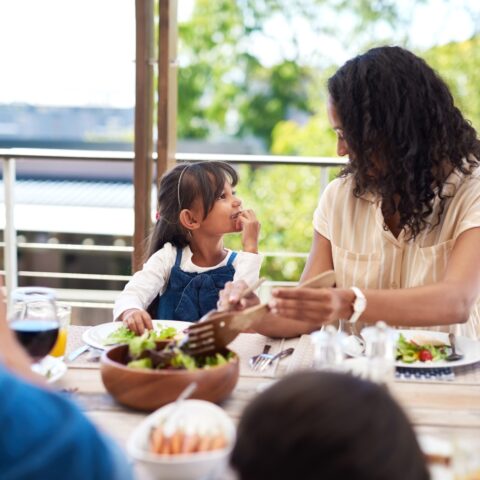How to Keep Kids Eating Consistently Across Homes and Schools

A child’s week of meals might stretch across several kitchens: breakfast at one parent’s house, lunch in the cafeteria, snacks at aftercare, dinner with grandparents, and birthday cake at a friend’s party. Relatives, babysitters, and neighbors add their own touches along the way. Dozens of adults shape kids’ eating habits, often without much coordination.
For parents, this can feel impossible to manage. What if a child has a sensitivity? What if one household keeps soda stocked and another bans it? For kids, though, this variety becomes part of how they learn. Each table is a place to test new flavors, notice how their body responds, and carry forward small rituals that help them feel secure no matter where they sit down to eat.
Children feel most secure when meals follow familiar patterns. That doesn’t mean the plate is always the same or that life never gets messy. It means rhythms repeat often enough to become expected. With that familiarity, kids develop a sense of ease with food and more confidence to handle differences across tables.
Support for Solo Parents
Carrying the responsibility for every meal alone can feel heavy, especially when time and energy are stretched thin. What matters most is providing a few simple rhythms that repeat often enough to feel reliable.
- Keep the anchors simple. Frozen broccoli, roasted sweet potatoes, hard-boiled eggs, or shredded chicken pulled from the fridge can combine into meals that are easy to recognize and quick to prepare. Using prepped ingredients rather than prepped meals lets you mix and match, while avoiding the palate fatigue that often comes with repeated leftovers.
- Track the signals. A three-column log (meal | activity | how I felt) can reveal whether discomfort is a coincidence or a pattern. Invite kids to join by circling a smiling, neutral, or frowning face after each meal. That small act helps them notice and describe their body’s response, a practice associated with better appetite self-regulation when caregivers use responsive, structured feeding.1,2 It also makes visible to your child—and to other caregivers—the active role you are taking in supporting both dietary needs and overall well-being.
Think of predictability for meals as less about a dynamic of control and more about your child’s experienced rhythm. When certain foods show up often enough, they can become familiar landmarks in a child’s week. Even in a busy household, that kind of familiarity creates a baseline where kids can relax into what’s known while still being open to what you explore as new together.
Recipe Spotlight: Ultimate Antioxidant Paleo Breakfast Bowl
Don’t let the fancy name fool you, this simple recipe is essentially berries topped with whipped coconut cream. With those two main ingredients, there are no grains or dairy to worry about. Kids can help assemble the bowl, too. Ask them to pick the berries, scoop the cream, or sprinkle toppings. It makes breakfast feel ritualistic and fun.
When Food Choices Become a Point of Disagreement
It’s common for caregivers to see the same food pattern in different ways. One might dismiss a reluctance to eat as “picky,” while another suspects a sensitivity. When adults clash, the child’s experience can get lost in the middle. Bringing the focus back to what the child actually says and shows can shift the conversation.
- Use the child’s words. “He says his stomach hurts after milk” is harder to ignore than a parent’s interpretation.
- Share neutral data. A food log or pattern tracker reduces the back-and-forth of opinion.
- Agree on anchor habits. Even limited consistencies—like always offering water with meals or keeping a fruit or vegetable on the plate—give a child something steady to count on.
- Focus on your own home. Kids don’t need identical rules everywhere for help eating consistently. They benefit from knowing what is reliable in the space they return to most often.
Caregivers’ intentions and attitudes around food strongly influence how children form their own eating patterns.3 Keeping decisions rooted in the child’s lived experiences helps preserve trust and keeps nourishment at the center, even when the adults don’t fully agree.
What to Do If Another Caregiver Won’t Engage
Sometimes, a parent or caregiver refuses to talk about food routines at all. That silence can be discouraging, but it doesn’t erase your child’s need for consistency.
- Anchor at home. Provide reliable meals and positive food language in your space. That baseline can give your child a sense of steadiness even if other environments feel unpredictable.
- Give your child tools. A “comfort card” tucked in a backpack can quietly remind them what foods help them feel good. It might be a handwritten list or a drawing labeled with your guidance.
- Model calm. Kids notice tension. When you frame choices as “what works best,” you give them clarity without setting up a direct conflict with other adults.
- Trust the long game. Evidence shows that repeated exposure to familiar food patterns in even one environment can shape children’s preferences and improve self-regulation.⁴
The absence of agreement doesn’t have to mean the absence of support. A child who knows at least one adult is paying attention learns that their needs matter, and that food can be a source of security even in divided households.
Bringing Other Caregivers into the Rhythm
Once you’ve clarified your kid’s eating patterns, the next step is bringing other adults into the loop. Relatives, teachers, or coaches may want to help but don’t always know how. Too many instructions can overwhelm, so clarity and simplicity work best.
- Send food, not instructions. A packed lunchbox or snack jar is easier to follow than a long list of rules.
- Frame positively. “She feels better with this” lands more clearly than “Don’t give her that.”
- Teach simple check-ins. A question like, “Does this feel good in your stomach?” helps a child notice their own response and keeps the tone supportive.
- Leave reminders. A short note in a lunchbox or backpack can speak for you when conversations aren’t possible.
Slip-ups will happen. What matters most is that your child learns they have steady ground to return to and that someone is paying attention.
Recipe Spotlight: Garden Veggie Chips
These baked, crispy chips are made from squash and spices. They’re Paleo-friendly, customizable, and more allergy-friendly than nut-heavy snacks. Kids can help roll out the vegetable mixture, cut it into chip shapes, and choose the spices. A snack that turns grabbing food into participation, not just convenience.
When Kids Eat Away from Home
Special occasions bring unpredictable menus. Instead of avoiding them, prepare kids to meet them with more confidence.
- Talk it through. Anticipate what foods may show up and plan how your child wants to respond. Practicing phrases and choices ahead of time helps them feel prepared.
- Send a backup. Pack a snack or treat they already enjoy so they don’t feel excluded.
- Practice simple self-advocacy. “Sometimes that food makes me feel bad, but I can have this instead.”
- Communicate quietly with hosts. A short note or a labeled container often works better than long explanations.
- Reflect afterward. Ask which foods felt good and which didn’t. Over time, these conversations build awareness and flexibility.
Even when plans go sideways, one event doesn’t undo the consistent eating patterns a child is learning at home. Each new setting becomes another place to practice noticing, choosing, and adapting.
Recipe Spotlight: Air Fryer Broccoli Tots
Crunchy, crispy, and bursting with a fun color, Broccoli Tots are lighter and easier to digest than traditional tater tots.
Consistency Is Key
Every child benefits from adults who notice and respond. Even when caregivers disagree or communication breaks down, a few steady practices can carry real weight. A piece of fruit that always shows up on the plate. A packed snack that follows them to school. A ritual that belongs to them, no matter whose kitchen they are in.
This article is for educational purposes only and is not a substitute for professional medical advice. Always consult your pediatrician for guidance on allergies, growth, or nutritional needs.
Frequently Asked Questions
Q: How can I keep my kids eating consistent if they eat at different homes each week?
A: Focus on what you can control: steady routines in your own home, simple swaps, and positive language. Even one consistent environment can give a child enough rhythm to feel steady in their eating habits.
Q: What should I do if my co-parent won’t talk about food routines?
A: Anchor in what happens under your roof. Use neutral language and give your child tools like a Comfort Card so they feel supported without needing adults to agree in every setting.
Q: How do I talk to grandparents or babysitters about my child’s food needs?
A: Keep it practical. Send food instead of long instructions, use positive framing (“she feels better with this”), and leave a short note when conversations aren’t possible.
Q: What are some easy food swaps kids usually accept?
A: Try coconut or almond yogurt instead of flavored dairy cups, smoothies or fruit-infused water instead of juice, nuts for chips, veggie noodles for wheat pasta, and air-fried chicken tenders for deep-fried ones.
Q: How do I prepare my child for birthday parties and sleepovers?
A: Talk together ahead of time about what foods may show up, pack a backup snack they enjoy, and practice phrases they can use to say no politely. Afterward, reflect on what felt good and what didn’t. Each new event is another chance to practice.
References
- Wood, A. C., Blissett, J. M., Brunstrom, J. M., Carnell, S., Faith, M. S., Fisher, J. O., Hayman, L. L., Khalsa, A. S., Hughes, S. O., Miller, A. L., Momin, S. R., Welsh, J. A., Woo, J. G., & Haycraft, E. (2020). Caregiver Influences on Eating Behaviors in Young Children. Journal of the American Heart Association, 9(10). https://www.ahajournals.org/doi/10.1161/JAHA.119.014520
- Russell, C. G., & Russell, A. (2020). “Food” and “non-food” self-regulation in childhood: a review and reciprocal analysis. International Journal of Behavioral Nutrition and Physical Activity, 17(1). https://ijbnpa.biomedcentral.com/articles/10.1186/s12966-020-00928-5
- Qutaibah Oudat, Miller, E. L., Couch, S. C., Lee, R. C., & Bakas, T. (2025). Understanding Caregivers’ Influence on Preschoolers’ Eating Behaviors: An Integrative Review Guided by the Theory of Planned Behavior. Children, 12(2), 163–163. https://www.mdpi.com/2227-9067/12/2/163
- Appleton, K. M., Hemingway, A., Rajska, J., & Hartwell, H. (2018). Repeated exposure and conditioning strategies for increasing vegetable liking and intake: systematic review and meta-analyses of the published literature. The American Journal of Clinical Nutrition, 108(4), 842–856. https://www.sciencedirect.com/science/article/pii/S0002916522029781?via%3Dihub
- LAMPORT, D. J., WU, S.-Y., DREVER-HEAPS, J., HUGUENIOT, O., JONES, D. J. W., KENNEDY, O. B., WILLIAMS, C. M., & BUTLER, L. T. (2021). Can Public Health Interventions Change Immediate and Long-Term Dietary Behaviours? Encouraging Evidence from a Pilot Study of the U.K. Change4Life Sugar Swaps Campaign. Nutrients, 14(1), 68. https://www.mdpi.com/2072-6643/14/1/68
Griffin McMath, ND
With a background in clinical practice, advocacy, and behavior change communication, Dr. McMath is passionate about advancing health literacy and empowering people to make informed decisions.
More About The Author




